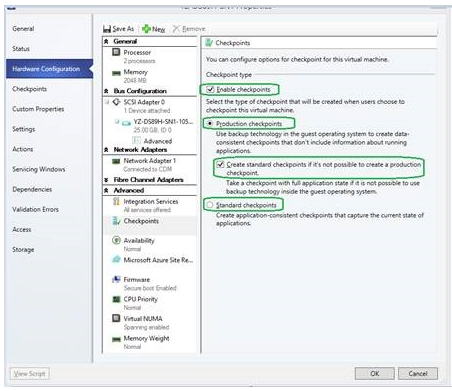~ Dipti Goyal | Software Engineer II

A little about Hyper-V Production Checkpoints
Production checkpoints allow you to easily create “point in time” images of a virtual machine which can then be restored later on in a way that is completely supported for all production workloads. This is achieved by using backup technology inside the guest to create the checkpoint instead of using saved state technology. For production checkpoints, the Volume Snapshot Service (VSS) is used inside Windows virtual machines, whereas Linux virtual machines flush their file system buffers to create a file system consistent checkpoint. If you want to create checkpoints using saved state technology you can still choose to use standard checkpoints for your virtual machine.
For any new virtual machines, the default is to create production checkpoints with a fallback to standard checkpoints. More details on this can be found here .
What’s new in VMM Checkpoint options :
Hyper-V has added 4 types for checkpoints:
- Disabled
- Production
- ProductionOnly
- Standard
We have implemented these types in VMM so let’s look at each of them in detail.
1. Disabled : This option disables the check-pointing ability on the VM. Once Checkpoint Type is set to Disabled , a checkpoint cannot be taken on that VM until it’s set to some other value.
Example: Set-SCVirtualMachine –CheckpointType Disabled

As you can see here, this sets the CheckpointType property on the VM to Disabled :

2. Production : Production checkpoints are application consistent snapshots of a virtual machine. Hyper-V leverages the guest VSS provider to create an image of the virtual machine where all of its applications are in a consistent state. The production snapshot does not involve the autorecovery phase during creation. Applying a production checkpoint requires the restored virtual machine to boot from an offline state just like with a restored backup. This is always more suitable for production environments.
Example: Set-SCVirtualMachine –CheckpointType Production

This sets the CheckpointType property on the VM to Production . With this option, if a production checkpoint fails for any reason, a standard checkpoint will be taken.

3. ProductionOnly : This option is the same as Production with one key difference: With ProductionOnly , if a production checkpoint fails then no checkpoint will be taken. This is different from Production where if a production checkpoint fails, a standard checkpoint will be taken instead.
Example: Set-SCVirtualMachine –CheckpointType ProductionOnly

As shown below, this sets the CheckpointType property on the VM to ProductionOnly :

4. Standard : With a Standard checkpoint, all of the memory state of running applications gets stored so that when you apply the checkpoint it’s back in the same state. For a production environment with a SQL server or Exchange server, this obviously would not serve the right purpose, therefore this type of checkpoint is typically more suitable for development and test environments.
Example: Set-SCVirtualMachine –CheckpointType Standard

This sets the CheckpointType property on the VM to Standard :

The examples above examples are for Set-SCVirtualMachine , however in VMM, CheckpointType can also be set during the following operations:
- New-SCVirtualMachine –CheckpointType
- New-SCHardwareProfile –CheckpointType
- Set-SCHardwareProfile –CheckpointType
- New-SCVMTemplate –CheckpointType
- Set-SCVMTemplate –CheckpointType
If you want to change this from within the VMM UI, here are the options:

This gives VMM users the flexibility to change the checkpoints based on their requirements.
I hope this is helpful and thanks for reading!
Dipti Goyal | Software Engineer II | Fabric Management
Get the latest System Center news on Facebook and Twitter :


App-V Team blog:
http://blogs.technet.com/appv/
ConfigMgr Support Team blog:
http://blogs.technet.com/configurationmgr/
DPM Team blog:
http://blogs.technet.com/dpm/
MED-V Team blog:
http://blogs.technet.com/medv/
Orchestrator Support Team blog:
http://blogs.technet.com/b/orchestrator/
Operations Manager Team blog:
http://blogs.technet.com/momteam/
SCVMM Team blog:
http://blogs.technet.com/scvmm
Server App-V Team blog:
http://blogs.technet.com/b/serverappv
Service Manager Team blog:
http://blogs.technet.com/b/servicemanager
System Center Essentials Team blog:
http://blogs.technet.com/b/systemcenteressentials
WSUS Support Team blog:
http://blogs.technet.com/sus/
The Forefront Server Protection blog:
http://blogs.technet.com/b/fss/
The Forefront Endpoint Security blog :
http://blogs.technet.com/b/clientsecurity/
The Forefront Identity Manager blog :
http://blogs.msdn.com/b/ms-identity-support/
The Forefront TMG blog:
http://blogs.technet.com/b/isablog/
The Forefront UAG blog:
http://blogs.technet.com/b/edgeaccessblog/
VMM 2012 R2